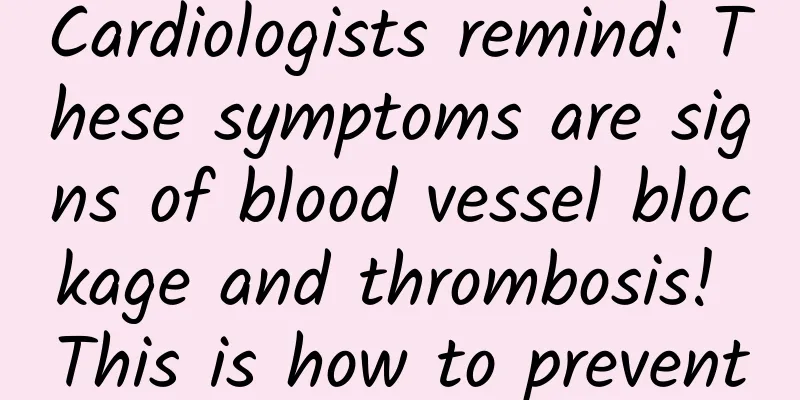Cardiologists remind: These symptoms are signs of blood vessel blockage and thrombosis! This is how to prevent

|
Vascular blockage is a very serious disease. Sometimes it is acute and there is no time to send out signals. For example, we always hear about sudden death of middle-aged people. The most important cause of sudden death is heart disease, and the main cause of heart disease is blockage of heart vessels, which is acute myocardial infarction. Therefore, sometimes there is no signal when this part of the blood vessel is blocked, which directly leads to cardiac arrest. Of course, there will be some signals if there is partial blood vessel blockage, but because there are blood vessels throughout the body, the signals given by blood vessel blockage in each part are different. The most common and dangerous blood vessel blockages currently include: cardiovascular, carotid, cerebral, pulmonary, lower limb arteries, etc. If it is a chronic blockage, sometimes there may be no symptoms, but for acute blood vessel blockage, most of them have some signals. We explain them one by one: 1. Cardiac artery blockage signal When the stenosis of the heart arteries exceeds 50%, it is called coronary heart disease. When the stenosis exceeds 70%, there may be symptoms. When the blockage is 99-100%, it is myocardial infarction. When the heart vessels are severely narrowed, angina pectoris will occur, and various angina pectoris signals are often sent out: precordial pain, chest pain, toothache, headache, throat tightness, back pain, shoulder pain, upper abdominal pain, chest pain, breath holding, etc. These signals last about 2-15 minutes each time, mostly occur after activities, and gradually ease after rest. If the heart artery is acutely blocked, it is acute myocardial infarction. The most typical symptom is persistent squeezing pain behind the sternum, accompanied by chest tightness and shortness of breath, and sweating. Atypical signals are the above-mentioned various angina pectoris that persist and do not relieve, which is a signal of myocardial infarction. The most serious is syncope and sudden death. The diagnosis can be confirmed through these signals plus electrocardiogram and myocardial enzymes, and the blood vessels must be opened immediately through thrombolysis or stenting to save lives. 2. Signs of Carotid Artery Blockage Severe carotid artery stenosis may cause dizziness, tinnitus, memory loss, blurred vision, insomnia, decreased vision, hemianopsia, blackouts, transient aphasia, hemiplegia, hemianopsia, etc. When the carotid artery is completely and acutely blocked, it will lead to cerebral infarction, which is a sign of cerebral infarction. The diagnosis can be confirmed through carotid artery ultrasound, and after the diagnosis is confirmed, treatment such as medication or surgery can be selected according to the specific situation. 3. Signs of cerebral vascular blockage Blockage of cerebral blood vessels is cerebral infarction, which may cause facial paralysis, aphasia, hemiplegia, hemiplegia, dizziness, headache, limb numbness, numbness of one side of the face or hands and feet, numbness of the tongue, lips, or one side of the upper and lower limbs, sudden weakness or inflexibility of one side of the limbs, slanted walking, unsteady walking, slurred speech, irrelevant answers to questions, nausea, vomiting or hiccups, facial paralysis and tongue paralysis, hemianopsia, coughing when drinking water, difficulty swallowing, loss of consciousness, intellectual disability, drowsiness, etc., and may even lead to death. It can be diagnosed through brain CT or MRI, and immediate thrombolytic or thrombectomy treatment is required after the diagnosis. 4. Signs of pulmonary artery obstruction That is pulmonary embolism. After pulmonary embolism occurs, it can also lead to sudden death. Common typical manifestations are difficulty breathing, chest tightness and shortness of breath, chest pain, low blood pressure, rapid heart rate, blacking out, fainting, collapse, pale complexion, cold sweat, cough, etc., or anxiety, fatigue, nausea, convulsions and coma, etc. Diagnosis can be made through these signals plus electrocardiogram or D2 aggregates, and confirmed through enhanced chest pulmonary vascular CT or angiography. After the diagnosis is confirmed, thrombolytic or anticoagulant therapy can be selected based on the specific situation. 5. Signs of lower limb artery blockage Intermittent claudication is the most typical signal of lower extremity artery blockage. Intermittent claudication refers to the sudden onset of unilateral or bilateral back and leg pain while walking, and numbness and weakness in the lower extremities, but it is fine after a short rest, and the same symptoms will reappear after walking for a while. Of course, the lower extremities may also become cold, painful, discolored, and local arterial fluctuations disappear. The diagnosis of lower limb thrombosis can be confirmed by ultrasound, and thrombolysis or anticoagulation treatment can be adopted after the diagnosis. The common blood vessel blockages we are talking about are all arterial blood vessels, but veins can also be blocked, such as lower limb vein thrombosis. 6. Lower limb venous thrombosis Blood clots form in the vein lumen due to various reasons, that is, blood flow in the deep veins is not smooth, blood clots are formed, and the blood vessels are blocked. After deep vein thrombosis occurs, about 50-75% have clear risk factors. Surgery, trauma, bed rest, tumor treatment (hormones, chemotherapy or radiotherapy), advanced age, heart or respiratory failure, nephrotic syndrome, obesity, smoking, varicose veins, hereditary or acquired thrombosis tendency, etc. These factors are usually closely related to deep vein thrombosis and may lead to the occurrence of deep vein thrombosis. The biggest danger of deep vein thrombosis is that once the blood clot breaks off, it will flow into the pulmonary blood vessels with the blood flow, causing blockage and leading to pulmonary embolism. The mortality rate of acute severe pulmonary embolism is as high as 15%, and it may even lead to sudden death, which shows the huge harm of deep vein thrombosis! That is, the pulmonary embolism we mentioned above is actually caused by the detachment of blood clots after venous thrombosis. In short, the signals of blood vessel blockage in different parts of the body are different, but when most of the signals are sent out, it means that the blood vessels are severely narrowed or completely blocked, and emergency treatment is the only option. However, most arterial blockages are caused by atherosclerosis, so atherosclerosis is the earliest signal of blood vessel blockage, but this signal is silent. We cannot feel it, we only know that high blood pressure, diabetes, high blood lipids, smoking, alcoholism, long-term sitting without exercise, obesity, unhealthy diet, staying up late, bad mood, etc. are all the root causes of atherosclerosis. Therefore, the three highs and an unhealthy lifestyle are the earliest signs of blood vessel blockage! |
<<: Geological disaster prevention and control
>>: How difficult is it for Tianwen-1 to accomplish three major tasks at one time?
Recommend
How to create good code
[[155438]] Someone recently emailed me asking me ...
How to improve product conversion rate?
When we start promoting a product, we must first ...
Xiaohongshu Music Account Project, teach you step by step to earn 500+ a day
I'm here again, haha. Today I recommend to yo...
Is operation and promotion difficult? You can't handle these three user attributes
The categories of operations include data operati...
Oil spill, why donate hair?
In the long history of the evolution of life on E...
Overview of advertising in February, inventory of top advertisers for App and brand promotion
According to the mobile advertising intelligence ...
SEM promotion: How important is the idea? 80% of bidders die on this!
After reading this article, you can improve in th...
China's three generations of trains in one frame! See China's railway speed counterattack
Produced by: Science Popularization China Author:...
Did Yutu crash due to speeding? How is that possible?
"Yutu was damaged by racing?" There are...
4 ways to operate B-side products!
New operators who have just entered the industry ...
From hearing aids to the future of wearable devices
On February 6, wearable devices have become more ...
Ward's Top 10 Engines of 2018 released: Japanese cars are the big winners, no German brands are on the list
In most people's impressions, Germany's a...
Summary of 8 popular interview questions in bidding SEM interviews!
First, ask about your bidding data. Companies whe...
Understanding Android naming conventions
Recently I have been answering questions from stu...
Xigua Video product operation analysis!
Xigua Video is an app owned by ByteDance. During ...









